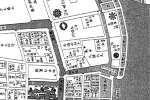

Jisaku's history
advance
Tsukiji Jisaku Establishment
Tsukiji Jisaku was founded in 1931 by Jisaku Honda, the first executive chef and owner of Tsukiji Jisaku. Jisaku Honda, who had successfully opened many restaurants in various parts of Japan and was even called the "Kappo King of Japan before World War II," had his heart set on entering the Tokyo market.
The first executive chef, Jisaku Honda, had a very dynamic personality and loved to celebrate and surprise people.
The huge stone lanterns and pagodas that can be seen in Tsukiji no Sansui were brought from all over Japan by Jisaku Honda, who was impressed by their size, so that each of them could be used as a couple. The "Bikkuri-dobin" by the entrance is said to have been made by Jisaku Honda at a Shigaraki kiln, and was so popular that it was reported in the newspapers when it was brought in. It is recorded that when the earthenware was brought in, there was such a fuss that it was reported in the newspapers.
When entering the Tokyo market, Jisaku Honda focused on the taste of the Tokyoite and Edo-mae taste. He believed that in order for his restaurant to succeed in Tokyo, he had to serve food that met the taste of Tokyoites. For this reason, he did not use any chefs from Kyushu other than himself, and hired only chefs he had personally recruited in Tokyo. This was a choice that could only have been made by "Chef Honda Jisaku," who knew the difference between Edo-mae cuisine and his own cuisine.
Ryotei Culture in Edo
It is said that it was during the Meiwa period (1764-1772) in the middle of the Edo period that restaurants that could be called "ryoriya" first appeared in Edo.
Until then, the only place to go for a sake party was Yoshiwara. From An'ei to Tenmei, famous restaurants were established one after another in Fukagawa, Ukiyo Koji, Mukojima, Nakasu, etc., and many of them were used by the samurai class as places to entertain guests.
When Jisaku Honda set up his restaurant in Tokyo, he insisted on setting up his restaurant along the Okawa (Sumida River). This is because the Ookawa River was a major transportation route from the Edo period through the Meiji, Taisho, and early Showa periods, and he was well aware that most high-class ryotei in the Edo period were located along the Ookawa River. He was deeply attracted to Edo's ryotei culture.
At the beginning of the Edo period, Edo's food and clothing culture was considered inferior to that of Kansai. This was due to the fact that most of Edo was a newly developed area that expanded with the influx of people from neighboring countries. However, as people's lives became more stable in the mid-Edo period, they gradually turned their attention to the culture of amusement and food.
Rise and Fall and Now
Founded in 1931, the year of the Manchurian Incident, Tsukiji Jisaku quickly gained a reputation among the public and became a huge success. Taking advantage of this, Jisaku Honda decided to expand his business to the continent with his Japanese cuisine.
During the war, Tsukiji Jisaku was offered as a dormitory for employees of Ishikawajima Shipyard.
In 1951, Jisaku Honda visited Toshiharu Hase. Hearing the long-cherished wish of his senior, whom he had known well before the war and looked up to as a mentor, Toshizashi's heart was greatly moved. Toshiji then decided to rebuild Tsukiji Jisaku.
While Jisaku was bought back with funds raised by Toshiharu Hase, Jisaku Honda prepared furnishings to suit his own tastes, brought back former chefs and waitresses, and prepared for the opening of the restaurant. On September 18, 1951, the new Tsukiji Jisaku was reopened.
Tsukiji Jisaku quickly regained its former popularity after opening, and its prosperity has become the foundation for today's restaurants.
The founder, Jisaku Honda, was an entertainer who truly wanted to entertain people in one thing: food culture. Toshizi Hase was a man with a strong sense of humanity and a sincere love of Japanese culture.
In the 80-odd years since our establishment, we have never forgotten that spirit and have devoted ourselves to it. We are sincerely grateful for your continued patronage and hope that you will enjoy our products, even if only for a moment.
Reference: Oedo Monoshiri Zukan, supervised by Kazuo Hanasaki, Shufu to Seikatsu-sha / Showa no Tokyo, Koyo Ishikawa, Asahi Shinbunsha
![Tsukiji Jisaku [Official] Ryotei Famous Mizutaki -Official direct reservation special offer-.](https://jisaku.co.jp/wp-content/uploads/2025/01/header-logo.png)
